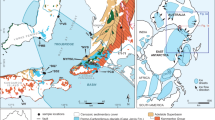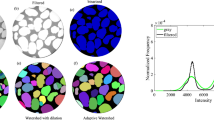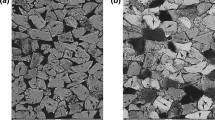Abstract
BROWN1 has drawn attention to the occurrence of features of “glacial origin” on sand grains from freshly weathered granite, from beaches, and from streams, all presumably lacking evidence of previous glacial history. We would like to clarify certain misleading statements presented by Brown1, not with the purpose of discrediting her findings but rather to argue with the interpretation of her data with respect to previously published literature on this subject. Krinsley and Donahue's transmission microscope work2 of 1968, referred to by Brown, has been greatly expanded on by much detailed work since the use of the scanning electron microscope to examine sand grain surface textures became widespread3–9. The statement made by Brown, quoting Krinsley and Donahue2 “that an assemblage of textures should characterize any one abrasive process, and that no single feature can be considered completely diagnostic,” was modified by Margolis and Kennett4 to read “… no single surface feature can itself be used to identify the origin of a sand grain, but rather that certain combinations of features are highly diagnostic when statistically significant percentages of the grains in the sample are examined”. With regard to Brown's statements on features of glacial origin Margolis and Kennett4 have written: “Features that in previous studies have been individually regarded as diagnostic of glacial origin such as large conchoidal fractures and breakage blocks, are also occasionally found on grains from high turbulence beaches and also occasionally on desert sands. When combinations of surface features are examined statistically, however, glacially derived sand grains exhibit unique combinations of characteristics”3,6. The point here is that the technique had advanced beyond presenting individual photographs as evidence of the history of a sand, and now involves a more quantitative treatment of data.
This is a preview of subscription content, access via your institution
Access options
Subscribe to this journal
Receive 51 print issues and online access
$199.00 per year
only $3.90 per issue
Buy this article
- Purchase on SpringerLink
- Instant access to full article PDF
Prices may be subject to local taxes which are calculated during checkout
Similar content being viewed by others
References
Brown, J. E., Nature, 242, 396 (1973).
Krinsley, D. H., and Donahue, J., Geol. Soc. Am. Bull., 79, 743 (1968).
Krinsley, D. H., and Margolis, S., Trans. N. Y. Acad. Sci., Ser. II, 31, 457 (1969).
Margolis, S., and Kennett, J. P., Am. J. Sci., 271, 1 (1971).
Margolis, S., and Kennett, J. P., Science, N. Y., 170, 1085 (1970).
Margolis, S., and Krinsley, D. H., Geol. Soc. Am. Bull., 82, 3395 (1971).
Margolis, S., thesis, Univ. California (1971).
Nordstrom, C. E., and Margolis, S., J. sediment. Petrol., 42, 527 (1912).
Krinsley, D. H., and Doornkamp, J., Atlas of Quartz Sand Grain Surface Textures (Cambridge University Press, in the press).
Doornkamp, J., and Krinsley, D. H., Sedimentology, 17, 89 (1971).
Fitzpatrick, K. T., and Summerson, C. H., Ohio J. Sci., 71, 106 (1971).
Schneider, H. E., Sedimentology, 14, 325 (1970).
Warnke, D. A., Am. J. Sci., 269, 276 (1970).
Krinsley, D. H., and Donahue, J., Geol. Mag., 105, 521 (1968).
Author information
Authors and Affiliations
Rights and permissions
About this article
Cite this article
MARGOLIS, S., KRINSLEY, D. Depositional Histories of Sand Grains from Surface Textures. Nature 245, 30–31 (1973). https://doi.org/10.1038/245030a0
Received:
Issue date:
DOI: https://doi.org/10.1038/245030a0



